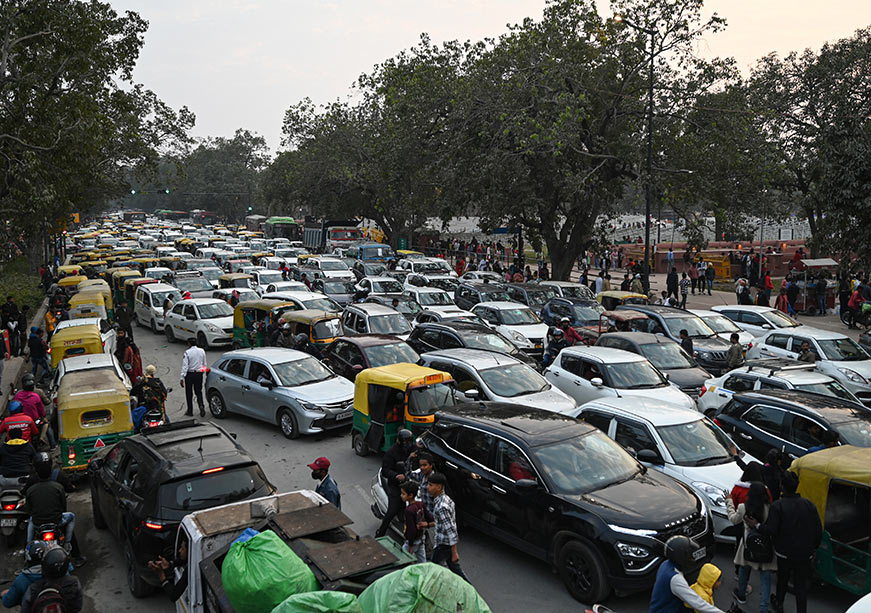-
CENTRES
Progammes & Centres
Location
India’s transport emissions are rising fast. Can CAFE norms integrate biofuels alongside EVs to drive a sustainable, low-carbon future for mobility?

Image Source: Getty
The transport sector in India contributes approximately 13 percent of the nation’s total carbon dioxide(CO₂) emissions. The demand for motor vehicles is bound to increase, corresponding to the anticipated growth in India’s urban population from 282 million in 2011 to 590 million by 2031. The number of cars, approximately 60 million in 2020, is expected to rise to 235 million by 2040 and reach 262 million by 2050. Consequently, CO₂ emissions from the transport sector will increase by 6 percent annually, underscoring the urgent need to mitigate the sector’s environmental impact.
As India’s energy generation progressively transitions to cleaner energy sources, alternative fuels, including enhanced adoption of electric vehicles (EVs), are critical to reducing CO₂ emissions. Supportive policies, such as the Faster Adoption and Manufacturing of Hybrid and Electric Vehicles (FAME), have contributed to an impressive growth in EV sales.
As India’s energy generation progressively transitions to cleaner energy sources, alternative fuels, including enhanced adoption of electric vehicles (EVs), are critical to reducing CO₂ emissions.
Furthermore, hydrogen, mainly green hydrogen, is gaining momentum as a promising alternative fuel. India’s National Hydrogen Mission (NHM) aims to prioritise hydrogen production, further reducing dependence on fossil fuels.
Biofuels, including ethanol, biodiesel, and compressed biogas (CBG), are also critical to minimising the transport sector’s carbon footprint. India’s Ethanol Blending Programme aims to achieve 20 percent ethanol blending by October 2025. During 2022-23, India’s ethanol-blending capacity of 17 billion litres reduced approximately 10.8 million metric tons of net CO2 emissions. Additionally, this initiative reduced India’s dependence on petroleum imports, contributing to foreign exchange savings exceeding INR 243 billion.
Fuel efficiency standards, such as the Corporate Average Fuel Economy (CAFE) norms across all vehicle types, further mitigate greenhouse gas (GHG) emissions and deliver economic gains by reducing fuel consumption and decreasing reliance on fuel imports. They foster the development and integration of alternative fuel technologies, advancing long-term sustainability by decarbonising the transport sector.
CAFE norms regulate original equipment manufacturers (OEMs) for fleet-wide CO₂ emissions, incentivising energy-efficient and less polluting vehicles. Applicable to all annual vehicle sales, they measure average fuel consumption (litres/100 kilometres) and CO₂ emissions (grams/km).T hey also reward manufacturers with ‘super credits’ for adopting fuel-saving technologies and alternative powertrains such as battery EVs (BEVs), plug-in hybrid EVs (PHEVs), and hybrid EVs (HEVs).
India implemented CAFE norms (Stage I) in 2017–18 and introduced stricter standards (Stage II) in April 2022. Initially limited to passenger cars, CAFE norms gradually encompassed heavy-duty, light, and commercial vehicles. Table 1 provides an overview of CAFE I and II norms for passenger cars:
Table 1: Overview of CAFE norms I & II
| Parameters | CAFE I | CAFE II |
| Effective Year | 2017-18 onwards | 2022-23 onwards |
| Average Kerb weight (Kg) | 1,037 | 1,082 |
| Fuel Consumption (Litres/100 km) | <5.5 | <4.78 |
| Average Co2 emission (grams of Co2/km) | <130 | <113 |
Source: Urja Dakshata Information Tool.
The CAFE norms’ super credits encourage low-emission technologies by giving Fuel Cell Electric Vehicles (FCEVs) and battery electric vehicles (BEVs) a multiplier of 3, plug-in hybrid electric vehicles (PHEVs) a multiplier of 2.5, and hybrid electric vehicles (HEVs) a multiplier of 2. This system allows each sale to garner multiple credits in fleet CO₂ calculations. They also give a reduction factor of 0.98 for regenerative braking, start-stop systems, and advanced transmission technologies, lowering their calculated CO₂ emissions and incentivising manufacturers to adopt cleaner technologies.
The Bureau of Energy Efficiency (BEE), in collaboration with key stakeholders, has proposed new standards, CAFE III (2027-2032) and CAFE IV (2033-2037), to further reduce average CO₂ emissions to 91.7 g/km and 70 g/km, respectively. Tables 2 and 3 represent CAFE III and IV’s revised emission credits based on vehicle types and CO₂-reducing technology:
Table 2: CAFE III and IV’s super credit system based on vehicle type
| Sr. No | Vehicle Type | Existing Volume Derogation Factor for Super Credit | CAFE III | CAFE IV |
| 2027-2032 | 2033-2037 | |||
| 1 | FCEV[1] | 3 | 5 | 5 |
| 2 | BEV[2] | 3 | 4 | 4 |
| 3 | PHEV (Minimum 7 KW battery pack)[3] | 2.5 | 2 | 1.5 |
| 4 | Strong Strong HEV[4] | 2 | 1.2 | 1 |
Source: BEE.
Table 3: CAFE III and IV’s super credit system based on CO2-educing technology
| Sr. No. | CO2 reducing technology | Existing Credit | CAFE III | CAFE IV |
| 2027-2032 | 2033-2037 | |||
| 1 | Ethanol* | NA | 0.95* | 0.95* |
| 2 | Regenerative braking | 0.98 | 0.99 | 1 |
| 3 | Start/Stop | 0.98 | 0.99 | 1 |
| 4 | Six or more gears | 0.98 | 0.99 | 1 |
| *Subject to the outcome of the BEE-IIP study. | ||||
Source: BEE.
CAFE III and IV enhance super credits for FCEVs from 3 to 5 and for BEVs from 3 to 4, emphasising the adoption of hydrogen fuel cells and fully electric powertrains to decarbonise the transport sector. However, the preferential treatment given to BEVs and the limited recognition of biofuels, despite their enormous potential for reducing carbon emissions, could constrain the effectiveness of the CAFE norms. For example, ethanol blending in petrol was increased to 12.06 percent in the Ethanol Supply Year (ESY) 2022-23 and approximately 14.60 percent in ESY 2023-24. Over the past decade, public sector Oil Marketing Companies (OMCs) like Indian Oil Corporation Limited (IOCL), Bharat Petroleum Corporation Limited (BPCL), and Hindustan Petroleum Corporation Limited (HPCL), have made significant efforts in ethanol blending, resulting in substantial foreign exchange savings of INR 1,086.55 billion as of 30 September 2024.
Though the inclusion of ethanol signifies the support for renewable fuels, its adoption is subject to the findings of the ongoing study by the BEE and the Institute for Industrial Productivity (IIP). Additionally, the norms’ derogation factor table does not specify the level of ethanol blending, which is critical to decarbonising the transport sector, enhancing rural economic growth, and increasing the incomes of farmers, as envisioned by the National Policy on Biofuels (NPB) 2018 and the Roadmap for Ethanol Blending in India 2020–2025. Leveraging the knowledge and expertise of the private sector: for example, PRAJ Industries is crucial to furthering these efforts, accelerating the adoption of advanced biofuels and CBG, and complementing the OMCs’ ongoing initiatives.
The National Biofuels Coordination Committee (NBCC) recently approved a phased blending of CBG with CNG and piped natural gas (PNG), with blending obligations becoming mandatory from Fiscal Year 2025-26.
Furthermore, the norms do not consider the potential of CBG, despite its higher negative carbon intensity than Compressed Natural Gas (CNG) and its alignment with the Sustainable Alternative Towards Affordable Transportation (SATAT) initiative. The National Biofuels Coordination Committee (NBCC) recently approved a phased blending of CBG with CNG and piped natural gas (PNG), with blending obligations becoming mandatory from Fiscal Year 2025-26. Therefore, the omission of CBG from the proposed CAFE III and IV norms is a missed opportunity to integrate this high-impact technology into the national decarbonisation strategy.
Similarly, the derogation factor table must consider biobutanol blending in diesel, which could catalyse faster GHG emissions reduction. Hydrogen is recognised only for FCEVs. The potential of other hydrogen variants, such as blue and green hydrogen, in internal combustion engines also warrants exploration. Their inclusion aligns with NHM’s goal to produce 5 MMT of green hydrogen annually by 2030, potentially abating 50 MMT of CO₂ emissions per annum.
A rigorous analysis of CAFE norms is imperative to ascertain the inclusion of all technologies and assess their potential benefits. Incorporating these advancements would create a level playing field for all technologies. A holistic approach that embraces diverse decarbonisation pathways—including biofuels, hybrid technologies, and alternative fuels—is crucial for India to fulfil its climate commitments and secure a sustainable future.
Nandan H Dawda is a Fellow with the Urban Studies programme at the Observer Research Foundation.
[1] Hydrogen FCEVs use fuel cell stacks to convert gaseous hydrogen to electricity, which is then stored in a battery to power the vehicle’s electric motor.
[2] BEV is solely powered by an electric power train.
[3] PHEV or Range Extended Electric Vehicles (REEV) are Strong HEVs providing ‘Off Vehicle charging’ (OVC) of ‘Rechargeable Energy Storage System (ReESS)’.
[4] Strong HEVs have a ‘stop-start’ arrangement, an ‘electric regenerative braking system’ and a ‘motor drive’ (the motor can propel the vehicle from a stationary condition).
[5] Based on consultation with leading automobile manufacturing companies.
[6] Well-to-wheel (WTW) Co2 emissions are generated across the value-chain of fuel combusted by the vehicle from production, transportation, transformation and distribution. They can be subdivided into well-to-tank (WTT) and tank-to-wheel (TTW) emissions.
The views expressed above belong to the author(s). ORF research and analyses now available on Telegram! Click here to access our curated content — blogs, longforms and interviews.

Dr Nandan H Dawda is a Fellow with the Urban Studies programme at the Observer Research Foundation. He has a bachelor's degree in Civil Engineering and ...
Read More +